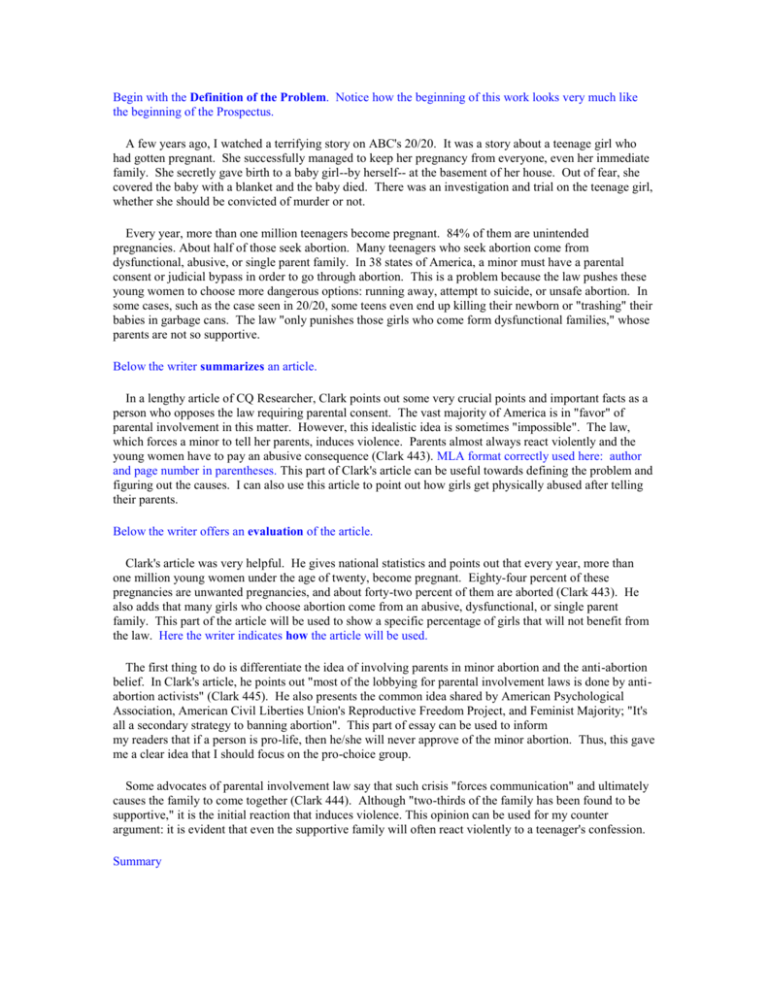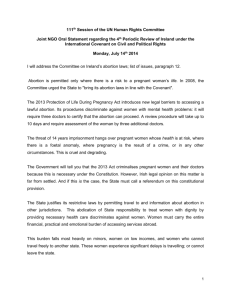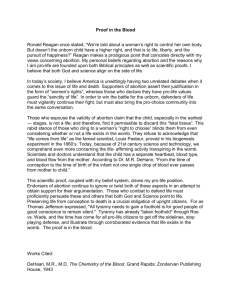Position paper sample/guidelines 1
advertisement

Begin with the Definition of the Problem. Notice how the beginning of this work looks very much like the beginning of the Prospectus. A few years ago, I watched a terrifying story on ABC's 20/20. It was a story about a teenage girl who had gotten pregnant. She successfully managed to keep her pregnancy from everyone, even her immediate family. She secretly gave birth to a baby girl--by herself-- at the basement of her house. Out of fear, she covered the baby with a blanket and the baby died. There was an investigation and trial on the teenage girl, whether she should be convicted of murder or not. Every year, more than one million teenagers become pregnant. 84% of them are unintended pregnancies. About half of those seek abortion. Many teenagers who seek abortion come from dysfunctional, abusive, or single parent family. In 38 states of America, a minor must have a parental consent or judicial bypass in order to go through abortion. This is a problem because the law pushes these young women to choose more dangerous options: running away, attempt to suicide, or unsafe abortion. In some cases, such as the case seen in 20/20, some teens even end up killing their newborn or "trashing" their babies in garbage cans. The law "only punishes those girls who come form dysfunctional families," whose parents are not so supportive. Below the writer summarizes an article. In a lengthy article of CQ Researcher, Clark points out some very crucial points and important facts as a person who opposes the law requiring parental consent. The vast majority of America is in "favor" of parental involvement in this matter. However, this idealistic idea is sometimes "impossible". The law, which forces a minor to tell her parents, induces violence. Parents almost always react violently and the young women have to pay an abusive consequence (Clark 443). MLA format correctly used here: author and page number in parentheses. This part of Clark's article can be useful towards defining the problem and figuring out the causes. I can also use this article to point out how girls get physically abused after telling their parents. Below the writer offers an evaluation of the article. Clark's article was very helpful. He gives national statistics and points out that every year, more than one million young women under the age of twenty, become pregnant. Eighty-four percent of these pregnancies are unwanted pregnancies, and about forty-two percent of them are aborted (Clark 443). He also adds that many girls who choose abortion come from an abusive, dysfunctional, or single parent family. This part of the article will be used to show a specific percentage of girls that will not benefit from the law. Here the writer indicates how the article will be used. The first thing to do is differentiate the idea of involving parents in minor abortion and the anti-abortion belief. In Clark's article, he points out "most of the lobbying for parental involvement laws is done by antiabortion activists" (Clark 445). He also presents the common idea shared by American Psychological Association, American Civil Liberties Union's Reproductive Freedom Project, and Feminist Majority; "It's all a secondary strategy to banning abortion". This part of essay can be used to inform my readers that if a person is pro-life, then he/she will never approve of the minor abortion. Thus, this gave me a clear idea that I should focus on the pro-choice group. Some advocates of parental involvement law say that such crisis "forces communication" and ultimately causes the family to come together (Clark 444). Although "two-thirds of the family has been found to be supportive," it is the initial reaction that induces violence. This opinion can be used for my counter argument: it is evident that even the supportive family will often react violently to a teenager's confession. Summary Sol Gordon's article from September/October issue of Humanist offered some very important facts. The majority of the teenagers who chooses abortion live with a single parent and "as many as 25% de not know who their father was" (Hager A-1). Many of the teenagers also come from dysfunctional families or abusive background. Teenagers who have a close relationship with their parents end up telling their parents. "This law does nothing form the functional families" he said. The law only "punishes the daughters of dysfunctional families" and leaves them to face the abusive and cruel parents and "further cruelty and abuse" (Hager A-1). This article will be used with Clark's article to emphasize the inadequate background of some pregnant teens. This law pushes young women to the edge and forces them to seek for more dangerous options: running away, suicide attempt, and unsafe abortion (Gordon 41). Telling their parents that they are pregnant is admitting to their sexual behavior and sexual misconduct. Most teenagers are more afraid of their parents' initial reaction than their pregnancy itself. This brings tremendous fear and anxiety, and "telling the parents" becomes the last resort for them. These pregnant teens would rather run away--as many as 200,000 girls each year--than to having to face their parents (Gordon 41). Evaluation Gordon's article was helpful because it provided very useful statistics. I can use this article to support my argument that many girls end up in a dangerous situation. Summary + evaluation In 1992, San Francisco Superior Court judge ruled that parental or judicial consent for an abortion was unconstitutional. This article from Los Angeles Times also strongly points out that such law "violates a minor's right to privacy under the California Constitution." The article also quotes Judge Maxine M. Cheseny saying that "the Great majority of minors possess the cognitive ability and maturity to make fully informed choices as to abortion" (Hager A-1). This article can be used as counter argument to those who think teenagers are too immature to decide for themselves. I had a private interview with a close friend of mine who had an abortion when she was eighteen years old. She was able to get an abortion by herself because she had reached the legal age. I asked her, "What would you have done if you got pregnant at 17 and the law required you to have a parental consent before the procedure?" There was a long silence. I asked her if she would have told her parents and she replied with "Hell, no!" She thought I was "crazy" and later told me that she "would have done any thing but to tell [her] parents" (Kelly). This interview clearly shows that for whatever reason, fear or embarrassment, a teenage girl does not have many options. To many girls, telling their parents is, literally, the last thing they would do. Clark also introduces a study done by John Hopkins School of Hygiene and Public Health in 1989. Black, teenage girls with similar socioeconomic background were monitored for two years after being tested for pregnancy. The girls who had abortion were less likely to become pregnant, less likely to have psychological problems, more likely to finish high school, and more likely to be economically stable (Clark 444). This study can be used to point out some of the benefits and possible out come of teenage abortion. Notice this assignment includes a Works Cited page. Be sure to check chapter 22, especially the sample paper at the end to see how to abide by the MLA format.






